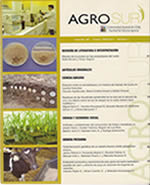Effect of hydraulic and mechanical stresses on the functional resistance and resilience of the porous system of a Ñadi (Aquands) under different land uses
Main Article Content
Abstract
The aim of the study was to analyze the functional resistance and resilience of the pore system of a Ñadi soil subjected to mechanical and hydraulic stresses. Undisturbed soil samples were collected at two depths (5 and 15 cm) in a Duric histic placaquands (series Alerce) under different land uses (natural forest: BN - naturalized grassland: PN). Air capacity (CA), plant available water (ADP) and air conductivity (kl) were determined before and after the soil had been subjected (separately) to hydraulic (in pressure cooker) and mechanical (in odometer) stress. The coefficient of linear extensibility (COLE) was used to quantify the resistance and resilience. The land use change caused a decrease of soil depth, exposing the A horizon in the soil surface under PN. The soil under BN was less resistant due to its higher COLE after being subjected to both applied stresses, however, it showed the higher mechanical resilience. The soil deformation at 5 cm in BN induced a decrease of CA and kl as well as a higher volume of ADP. The hydraulic and mechanical history of the soil under the naturalized pasture (PN), increased the mechanical stability which allows to maintain soil pore functions. The functional resistance and resilience of soil pores determined by COLE correlate positively with the organic carbon content (CO).

